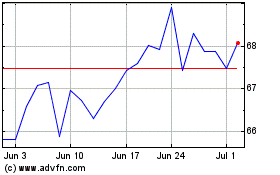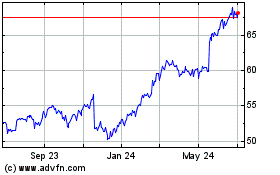Roku Reboots Streaming Video Lineup With Cheap HD and High-End 4K HDR Boxes
September 26 2016 - 9:50AM
Dow Jones News
For the first time in years, Roku Inc. is revamping its entire
line of streaming media boxes, keeping only one model. The company
is betting big on 4K boxes, which it introduced last year. But it
also is aiming for the bottom of the market with a basic $30
high-definition streamer.
Three new video players in the line can stream in 4K (aka Ultra
HD), an increasingly popular resolution of TV that has four times
the pixels of a 1080p HDTV. Two of those models also support high
dynamic range (HDR), a more vivid color palette and contrast range
encoded in the newest shows and movies from Netflix Inc.,
Amazon.com Inc.'s Prime and other services.
The old Roku 1, 2, 3 and 4 have been discontinued. Joining the
$50 Roku Streaming Stick on the lower end are two players that max
out at 1080p high-def resolution.
The $30 Roku Express is the size of a pack of bubble gum. It has
an HDMI port to connect to current HDTVs and an infrared remote. A
step-up model, the $40 Roku Express Plus, adds a composite cable
port that allows it to be connected to older TV sets that don't
have an HDMI port. (The Roku Express Plus will be sold exclusively
in Wal-Mart Stores Inc. locations.)
The 4K models start at $80, a substantial drop from the $130
Roku 4. The new 4K models also are 40% smaller than their
predecessor.
The Roku Premiere ships with an infrared remote and can handle
4K video at up to 60 frames per second. Roku says it has up to 15
different 4K-capable channels, including Amazon, Netflix, YouTube
and Vudu.
The $100 step-up Roku Premiere Plus adds HDR video support plus
an Ethernet port and a point-anywhere radio-frequency remote with a
headphone jack.
The flagship streaming box, and most expensive model, is the
$129 Roku Ultra. It adds a digital audio out port and both a USB
port and a MicroSD card slot. It comes with a radio-frequency
remote that features a built-in microphone to allow voice controls,
and there are game-controller buttons on the back too. It also is
the only device in Roku's new lineup that has a button to locate
its remote, should it get lost.
Why so many? A large lineup is good for business because it
means more retail shelf space at Best Buy Co., Target Corp. and
other big-box stores. Roku says people like having choices. The
company also says that while its main competitors, Apple Inc.'s
Apple TV and Google's Chromecast, have outsold it at times, Roku
consistently ranks highest in streaming hours.
To benefit from the 4K and HDR video, you'll need a 4K HDR
television. (Technically, it has to support the HDR10 format, but
nearly every HDR TV does.)
The funny thing is, most of those fancy TV sets have streaming
apps built into their operating systems. So why would anyone who
spends $2,000 on a new "smart" TV go spend another $130 on a
streaming box? The best reason would be if you aren't getting what
you want on your fancy new 4K TV. Roku already has a huge number of
apps. And the chances are great that it will get new channel apps
sooner than your smart TV will.
Roku also is trying to be helpful by collecting all the
available 4K content into a showcase channel. Usually, it is very
hard to find 4K content, even with all of the right subscriptions.
Roku has more than 100 channels in its universal search, so it is
easier to find exactly what you want.
That said, Roku's days of selling boxes could be limited, which
is why it is focusing more on providing an operating system for
TVs. Currently, in the U.S., you can find its software powering
sets from Haier Electronics Group, Hisense Electric Co., TCL Corp.,
Sharp Corp. and Best Buy's Insignia. A Hitachi Ltd.-branded Roku TV
is due out soon.
Write to Nathan Olivarez-Giles at
Nathan.Olivarez-giles@wsj.com
(END) Dow Jones Newswires
September 26, 2016 09:35 ET (13:35 GMT)
Copyright (c) 2016 Dow Jones & Company, Inc.
Walmart (NYSE:WMT)
Historical Stock Chart
From Mar 2024 to Apr 2024

Walmart (NYSE:WMT)
Historical Stock Chart
From Apr 2023 to Apr 2024
